
The Solomons cockatoo, also known as the Ducorps's cockatoo, Solomons corella or broad-crested corella, is a species of cockatoo endemic to the Solomon Islands archipelago. This small white cockatoo is larger than the Tanimbar corella yet smaller than the umbrella cockatoo. The species is common across most of the Solomons, absent only from Makira in the south. It inhabits lowland rainforests, secondary forests, cleared areas and gardens.

Eclectus is a genus of parrot, the Psittaciformes, which consists of four known extant species known as eclectus parrots and the extinct Eclectus infectus, the oceanic eclectus parrot. The extant eclectus parrots are medium-sized parrots native to regions of Oceania, particularly New Guinea and Australia. Males are mostly bright green, females are predominantly bright red. The male and female eclectus were once thought to be different species. The conservation status of the remaining species is least concern. Eclectus parrots do well in captivity, and are a very popular pet across the world.

The thick-billed parrot is a medium-sized parrot endemic to Mexico that formerly ranged into the southwestern United States. Its position in parrot phylogeny is the subject of ongoing discussion; it is sometimes referred to as thick-billed macaw or thick-billed conure. In Mexico, it is locally called guacamaya ("macaw") or cotorra serrana. Classified internationally as Endangered through IUCN, the thick-billed parrot's decline has been central to multiple controversies over wildlife management. In 2018, the estimated wild population in Mexico was 1,700.
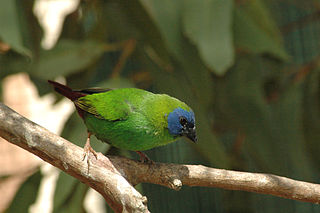
The blue-faced parrotfinch is a locally common species of estrildid finch found in north-eastern Australia, Japan, Indonesia, Federated States of Micronesia, France (introduced), New Caledonia, Palau, Papua New Guinea, the Solomon Islands and Vanuatu. It has an estimated global extent of occurrence of 10,000,000 km2.

The blue-backed parrot, also known as Müller's parrot is a large, endangered species of parrot endemic to the Philippines. It is found in tropical moist lowland forests. Flocks are small and often active at night. Its main threats are habitat loss and trapping for the pet trade.
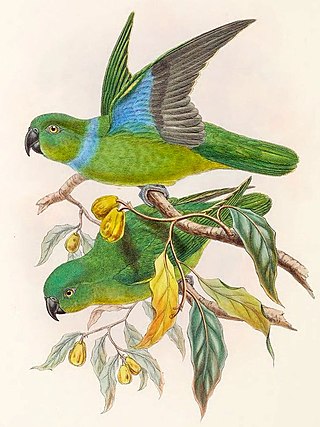
The blue-collared parrot also known as simple parrot, lilac-collared song parrot, or lilac-collared Geoffroy's parrot, is a parrot found in the higher elevations of New Guinea. It is found from 500 to 2300 m, mainly between 800 and 1900 m. It is 23–25 cm, mainly green with a black beak, yellow wing bend, blue underwing coverts, and a pale yellow iris. Adult males have a blue collar across upper breast to lower neck above the mantle, adult females have some blue on the rear crown. Juveniles have no blue and a paler bill. There are two subspecies:

The blue-crowned lorikeet, also known as the blue-crowned lory, blue-crested lory, Solomon lory or Samoan lory, is a parrot found throughout the Lau Islands (Fiji), Tonga, Samoa, Niue and adjacent islands, including: ʻAlofi, Fotuhaʻa, Fulago, Futuna, Haʻafeva, Niuafoʻou, Moce, Niue, Ofu, Olosega, Samoa, Savaiʻi, Tafahi, Taʻu, Tofua, Tonga, Tungua, ʻUiha, ʻUpolu, Varoa, Vavaʻu, and Voleva. It is a 19 cm green lorikeet with a red throat, blue crown, and belly patch shading from red at the top to purple at the bottom.

The duchess lorikeet is a species of parrot in the family Psittaculidae. It is the only species placed in the genus Charmosynoides. It is found throughout the Solomon Islands archipelago. Its natural habitats are subtropical or tropical moist lowland forest, subtropical or tropical moist montane forest, and plantations. It is threatened by habitat loss.
Meek's lorikeet is a species of parrot in the family Psittaculidae. It is found on Bougainville Island in Papua New Guinea and the Solomon Islands. Its natural habitats are subtropical or tropical moist lowland forest and subtropical or tropical moist montane forest. It is threatened by habitat loss.
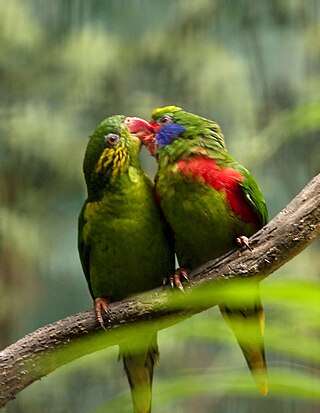
The red-flanked lorikeet is a species of parrot in the family Psittaculidae. It is found in Mollucas, New Guinea and the Bismarck Archipelago. Its natural habitats are subtropical or tropical moist lowland forests and subtropical or tropical mangrove forests. Only the adult males have the red plumage on the head and sides.

Geoffroyus is a genus of parrot in the family Psittaculidae. The four species are found in and around New Guinea, the Solomon Islands, northern Australia and the islands of Indonesia. It contains the following species:
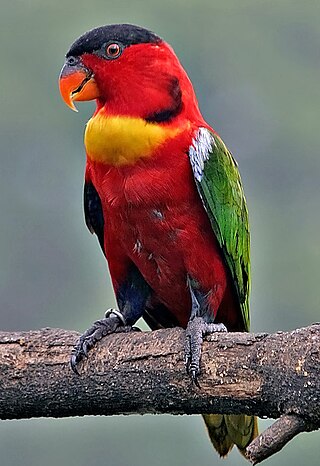
The yellow-bibbed lory is a species of parrot in the family Psittaculidae. It is endemic to the southern Solomon Islands.
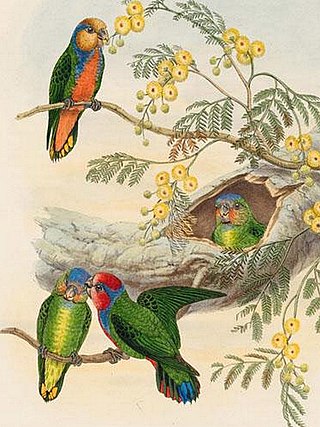
The red-breasted pygmy parrot is a species of parrot in the family Psittaculidae. Its natural habitat is the boreal forests, subtropical or tropical dry forests, and subtropical or tropical moist lowland forests of the Maluku Islands and Melanesia.

Finsch's pygmy parrot, also known as the emerald pygmy parrot and green pygmy parrot, is a member of parrot family Psittacidae inhabiting tropical rainforest regions of islands in Papua New Guinea, the Solomon Islands, and the Bismarck Archipelago.

The New Zealand parrot family, Strigopidae, consists of at least three genera of parrots – Nestor, Strigops, the fossil Nelepsittacus, and probably the fossil Heracles. The genus Nestor consists of the kea, kākā, Norfolk kākā and Chatham kākā, while the genus Strigops contains the iconic kākāpō. All extant species are endemic to New Zealand. The species of the genus Nelepsittacus were endemics of the main islands, while the two extinct species of the genus Nestor were found at the nearby oceanic islands such as Chatham Island of New Zealand, and Norfolk Island and adjacent Phillip Island.

Parrots, also known as psittacines, are birds of the roughly 398 species in 92 genera comprising the order Psittaciformes, found mostly in tropical and subtropical regions. The order is subdivided into three superfamilies: the Psittacoidea, the Cacatuoidea (cockatoos), and the Strigopoidea. One-third of all parrot species are threatened by extinction, with higher aggregate extinction risk than any other comparable bird group. Parrots have a generally pantropical distribution with several species inhabiting temperate regions in the Southern Hemisphere, as well. The greatest diversity of parrots is in South America and Australasia.

The parrot subfamily Psittaculinae consists of three tribes: the Polytelini with three genera, the Psittaculini or Asian psittacines, and the pygmy parrots of the Micropsittini tribe.

The Timneh parrot, also known as the Timneh grey parrot or Timneh African grey parrot, is a West African parrot. Formerly classified as a subspecies of the grey parrot Psittacus erithacus timneh, it is now considered a full species Psittacus timneh. In aviculture, it is often referred to by the initials TAG and is commonly kept as a companion parrot.
The Rennell parrot is an island species of parrot, found on Rennell Island in the Solomons. It is normally considered a subspecies of the song parrot but differs from it in its larger size, its blue collar being more lavender in colour and extending to the breast, and a more strongly grey-blue tone to the female's head. Population size is estimated at 5,000–20,000 individuals. Although only present in a small range, it is not currently considered threatened.

















